A central air conditioning unit is a sensible yet expensive addition to spacious homes, because it can cool your whole home via duct systems. Meanwhile, floor-mounted or wall-mounted ACs, portable ACs, and window ACs are worthwhile options for cooling small spaces.
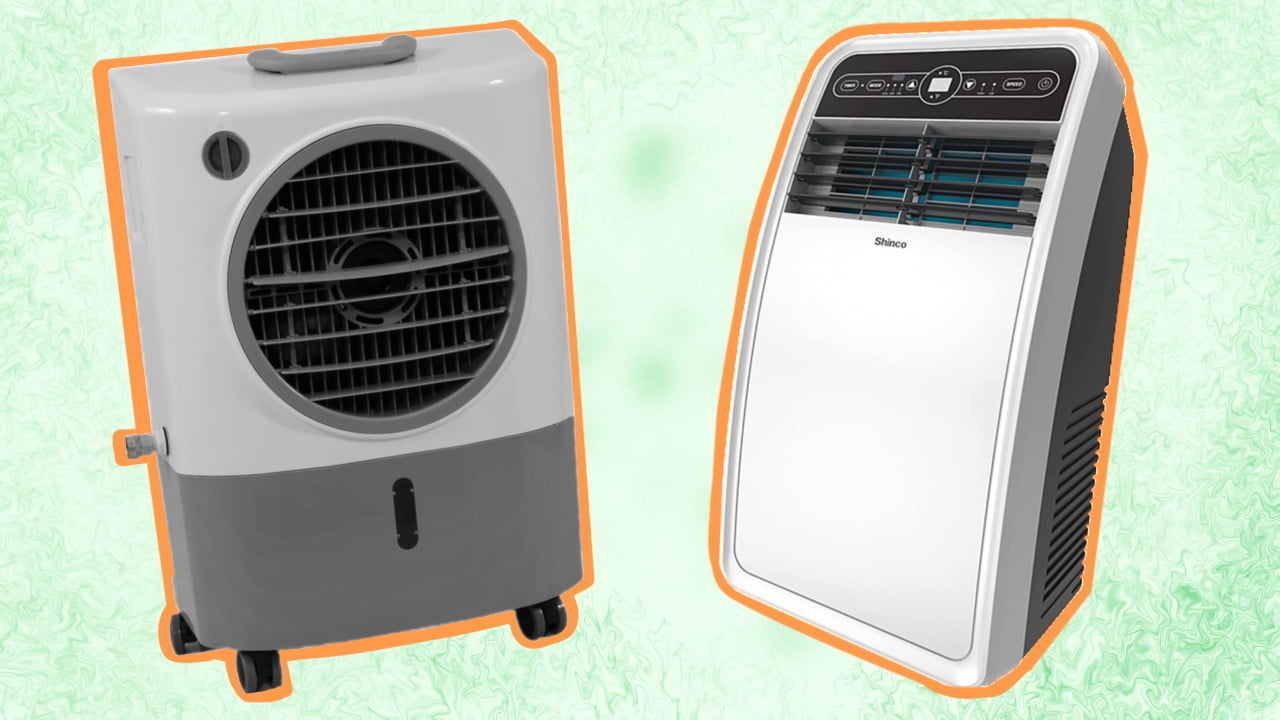
Sitting under a shade or diving into a pool can help you remain cool, but an air conditioner is a necessity to beat the heat.
There are a plethora of options, like ductless mini split systems, portable air conditioners, and central air conditioning units, so how’d you know which one is the right pick? That’s what this guide is all about, as I explore the ins and outs of each type of air conditioner.
Types Of Air Conditioners
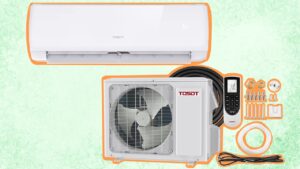
No matter the type of air conditioner you choose, every unit has two sets of metal coils– one coil absorbs heat while the other disperses it outdoors. The key component of air conditioning systems is the refrigerant– a liquid mix that transmits heat between the coils.
On this basis, air conditioners are divided into two categories:
- Split-system AC units
- Stand-alone AC units
5 Different Types Of Split-System Air Conditioning Units
1. Central Air Conditioners – A Wholesome Solution For Luxurious Homes

Source: Cielowigle
A central air conditioner, though luxurious, is the most common air conditioning unit found in a variety of homes in the United States. One of the reasons contributing to its popularity is that it is a duct system air conditioner, meaning it can cool the entire apartment or home easily and quietly.
Consisting of two units, the central air conditioning system has an evaporative unit nestled beside the furnace and a condensing unit housed outside. In central air conditioners, refrigerant tubing connects the evaporative unit with the condensing one.
The condensing unit of the central air conditioner produces cool air that is pushed to the evaporative unit. Later, the evaporative unit propels the cool air throughout the space via air ducts, similar to a furnace.
Although central air conditioning units are regulated by a thermostat, they can be equipped with smart capabilities. Therefore, users can turn it on or off, set cooling cycles, and adjust the temperature as per their needs.
Note that installing a central air conditioner is bothersome, although it’s safe to say that it is an easy-to-operate system. Installation alone can cost as much as $10,000 because the ceilings and walls are torn down to install ductwork.
Obviously, it isn’t a DIY task that you can pull off with ease, so hiring an expert engineer beforehand will be the best bet.
Advantages Of A Central Air Conditioner
- Easy to operate
- Requires less maintenance
- Highly efficient
- Relatively quiet operation
- Programmable thermostats help save on electricity bills
Disadvantages Of A Central Air Conditioner
- High installation cost
2. Floor Mounted Air Conditioners – Stronger Yet Quiet Split-System AC
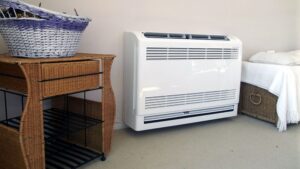
Source: Cielowigle
Prefer split systems air conditioners but are short on space? Floor-mounted air conditioners would be the best bet for your spacious apartment.
The portable unit sits indoors on the floor, so the evaporator fans work to remove the moisture formed inside the unit. Meanwhile, the outdoor unit can be fitted without any ductwork or major preparations.
A floor-mounted AC is a single self-contained unit that can be moved from one space to another with ease. Its portability is what makes it a viable option for buildings constructed with glass or other fragile materials. Portable units are also an excellent option for spaces with tilted walls, such as attics.
As for the installation, floor-mounted air conditioners can either be kept on the floor or installed up to 6 inches higher on the wall. Through a small hole in the wall, floor-mounted units are linked to the outdoor unit.
Irrespective of whether you place it on the floor or install it on the wall, checking the air filters of such air conditioners is easy. Another advantage of a floor-mounted air conditioner is that it cools a space quicker than wall-mounted ACs, as the unit blows air directly.
Nevertheless, floor-mounted air conditioners need free space to function efficiently; otherwise, they won’t be able to circulate air properly. And more than one portable unit can be connected to a single outdoor AC shell, i.e., a generator with a compressor and ventilator.
Advantages Of A Floor-Mounted Air Conditioner
- Easy to install
- Ideal for small and compact spaces as it doesn’t occupy much space
- Doubles up as a dehumidifier
- Built-in ionizer
Disadvantages Of A Floor-Mounted Air Conditioner
- The outdoor unit generates a lot of noise
3. Mini-Split System Ductless Air Conditioners – Better Efficiency Ductless AC
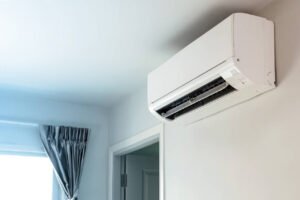
Source: Cielowigle
Not every residence has large duct systems for dispensing cool or warm air through the space. In certain homes, expansions are done, or guest rooms are built after installing a heating, ventilation, and air conditioning (HVAC) system.
Either way, a mini-split system ductless air conditioner would be a valuable addition. These types of air conditioners are a fusion of one or more indoor units and an outdoor unit with a condenser (heat transfer) and compressor.
Equipped with air blowers, the indoor unit is installed on a wall and is connected to the outdoor unit via tubing that carries the refrigerant. As the traditional units are compact, they can heat or cool small spaces, but not too many rooms. That is why they are more common among people looking for a permanent alternative to window air conditioners.
A mini-split air conditioner is much more efficient than other types of air conditioners in terms of energy consumption. However, if you intend to install it in every room of your home, it will be heavy on the pockets.
Although mini-split air conditioners come with remote control, you can pair them with a smart AC controller and operate them from anywhere at the push of a button.
Advantages Of A Ductless Mini-Split Air Conditioner
- Installation is a breeze as it doesn’t require ductwork
- Compatible with smart AC controller
- Energy-efficient
- Doesn’t produce too much noise
Disadvantages Of A Ductless Mini-Split Air Conditioner
- Not meant for cooling large spaces
4. Ceiling-Mounted Air Conditioners – High-Capacity Units Make Them Ideal For Offices

Source: Learnmetrics
As the name suggests, ceiling-mounted air conditioners are installed on the ceiling, including suspended ones, so they are considered appropriate for commercial spaces. These types of air conditioners are cassette-like units that are attached to the air pipes of a building.
Two reasons why ceiling-mounted air conditioners are much sought-after are power and aesthetics. Speaking of power, the airflow of this type of air conditioner is connected to the central airflow. That means it can replace up to 7 portable air conditioners and 5 window AC units.
Coming to aesthetics, these air conditioners boast a modern-looking design, meaning they do not stick out of the ceiling. In this system, the only thing that protrudes from the ceiling is the 4 outlet louvers.
As they are installed on the ceiling, it’s understandable that air flows vertically instead of horizontally. However, they can be mounted on the walls for a ‘sideways breeze.’
But ceiling-mounted air conditioners are expensive, so installing them in residential spaces won’t be a sound decision.
Advantages Of A Ceiling-Mounted Air Conditioner
- Distributes air evenly
- Saves a lot of space
- Relatively quiet operation
- Room temperature can be adjusted
Disadvantages Of A Ceiling-Mounted Air Conditioner
- Expensive
5. Air Source Heat Pumps – Effective In Mild Climates

Source: Welterheating
The air source heat pump is a cooling solution worth considering for homes with ductwork because of its low maintenance. Like a central air conditioning system, air source heat pumps use electricity instead of fuel to dispense cold and warm air across a space.
During the winter months, this system draws in concentrated warm air circulating outdoors and transports it into your home. Conversely, it absorbs the warm air from your home and throws it outside to keep your space cool during summer.
Unlike other home air conditioners, air source heat pumps are energy-efficient and a viable cooling solution for places with mild climates. But I wouldn’t suggest installing these devices in Minnesota because its winters and summers are anything but mild.
If you still wish to install one of these systems in your homes, I suggest using it in tandem with your existing system (air conditioner) to increase its efficiency.
Advantages Of Air Source Heat Pump
- Doesn’t turn off and on frequently like a gas furnace
- Economical option for places with milder climates
- Distributes heat and cool air evenly throughout the entire house
- Energy-efficient
Disadvantages Of Air Source Heat Pump
- Installation can be costly
Types Of Stand-Alone AC Units
1. Portable Air Conditioners – Ideal For Single-Room Cooling
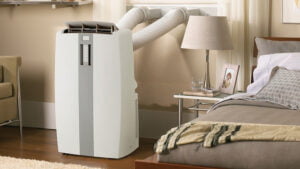
Source: Cielowigle
Of late, portable air conditioners have become a popular pick among homeowners and why not? You need not mount them on walls or ceilings like other types of AC units. Instead, they come with wheels, so they can be moved from one room to another without fuss like a vacuum cleaner.
Unlike other air conditioners, portable units are small and their capacity ranges between 5,000 BTU (British Thermal Unit) and 14,000 BTU. As per the EnergyStar BTU chart, a 10,000 BTU portable air conditioner will be suitable for a 400 to 450 square feet single-room ceiling space.
The only drawback of a portable air conditioner is the air pipe (fluid conveyance) also needs to be moved along with the unit, so that’s a hefty task. Also, every portable air conditioner comes with a long exhaust system (hose), which could range between 4” and 6” in diameter.
Whichever space you put it in, you must make sure that there is a casement window or a sliding door. That’s because you will have to place the other end outdoors to release hot air. Despite that, I’d say that a portable air conditioner is a practical addition to small spaces because you can get a good one for as little as $500.
Advantages Of A Portable Air Conditioner
- Ideal for small spaces
- Comes with built-in wheels for easy portability
- Easy on the pockets
- Doesn’t require frequent maintenance
- Piping and plumbing aren’t required to install it
Disadvantages Of A Portable Air Conditioner
- Low-capacity compressor
2. Window Air Conditioners – European ‘Through-The-Wall’ Air Conditioners
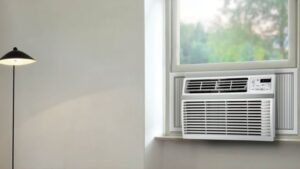
Source: Cielowigle
A cost-effective alternative to central air conditioners is a window air conditioner, which is quite popular in Europe. Compact yet powerful, window air conditioners are self-contained units that are designed for windows with the front portion indoors and the rear outdoors. Although you can drill a hole to install this air conditioner, I advise you to mount it on a window to be on the safe side.
On top of that, a window AC unit is equipped with a fan to release heat and condensation outside while pushing cold air into the space. What I particularly like about window units is they can be used with wireless devices and remote controls, provided they have smart system capabilities.
Compared to a central air conditioning unit, the air output of a window air conditioner is limited. So, you will either have to go for a large unit, install several ACs in your commercial space, or run the AC alongside multiple fans to cool the space effectively.
Although most people try to DIY install window air conditioners, I would suggest calling for professionals. That’s because these units can fall out if they aren’t mounted properly, injuring individuals passing below.
With window air conditioners, the thickness of the wall also plays an important role in determining their efficient energy use. So, before you start with the installations, make sure to check if your wall is thicker than 9” or not. If you mount them on walls thicker than 9”, the airflow will be hindered and the unit will become energy inefficient.
A few advanced models of window air conditioner units can also be used for heating the room. So, you can go for them if you don’t mind spending a tad bit on ACs.
Types Of Window Air Conditioners
Designed for single-level homes and apartments, window air conditioners are manufactured in a variety of sizes. So, finding a large window air conditioner for your spacious bedroom or living room won’t be a problem.
As for the style, window air conditioners are available in multiple varieties:
- Saddle over-the-sill window air conditioners – They are placed over the windowsill, although the majority of the unit is fixed beneath it.
- Low-profile window air conditioners – They are no more than 14 to 15 inches long.
- Vertical or casement air conditioners – They are designed for narrow windows.
Advantages Of A Window Air Conditioner
- Low upfront cost
- Multiple options
- Easy to install
- Energy efficient
Disadvantages Of A Window Air Conditioner
- A bit noisy
3. Wall-Mounted Air Conditioners – Ideal For Older Buildings

Source: Learnmetrics
Do you reside in older buildings that get scorching hot in summer? A wall-mounted air conditioner will save you from the burning heat by releasing cold air into your home.
These air-conditioning units come with strong supporters; hence, you can mount the air conditioner on the wall without any difficulty. After installing the air conditioner, you will have to mount 2 air pipes at the back of the unit through the wall so that hot air can be released outside.
Since the installation isn’t as straightforward as with other air conditioning systems, like portable air conditioners, hiring professionals will be a sensible decision. This air conditioning system is also bigger than other air conditioner types, which is another reason I suggest refraining from DIY installations.
Note that if you run this cooling system regularly, the wall can get quite hot; even the air pipes meant for dispersing heat will warm up.
Wall-mounted air conditioners also come with a heating system, although you will have to fork out a few dollars to get your hands on them. One benefit of investing in them is that the unit will circulate hot air throughout the room and keep you warm during the winter months.
Advantages Of A Wall-Mounted Air Conditioning System
- Better cooling capacity than window air conditioners
- Energy-efficient
- Relatively quiet air conditioning system
- Improves indoor air quality by minimizing allergens
- Easy to maintain
Disadvantages Of A Wall-Mounted Air Conditioning System
- Installation is challenging
Other Different Types Of Air Conditioners
1. Geothermal Air Conditioners
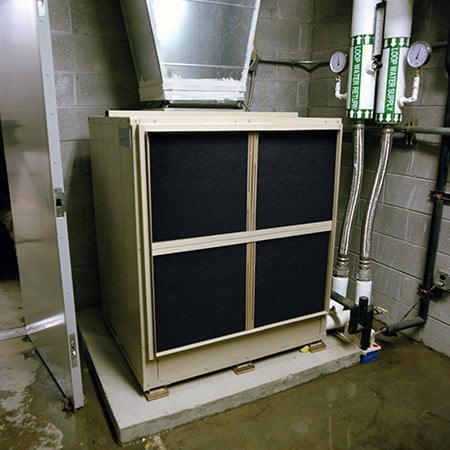
Source: EPA
An excellent alternative to a central air conditioning unit is a geothermal air conditioner for large homes. Cool air is transferred via the existing ducts of the home to lower the temperature so that it becomes cool.
Geothermal air conditioners also doubles as a heater and insulate your home during colder months. Compared to a central air conditioning system or a standard furnace (central heating), such a system consumes less energy, so the energy cost is less. The installation costs, however, are significantly more than that of other systems, ranging between $15,000 and $35,000.
The operations of geothermal air conditioners are fairly simple– they circulate water underground. Therefore, in the summer months, the water transports heat from the house and disperses it deep into the earth (acting as a heat sink).
During winter, heat is absorbed by the cold water from the earth at a depth of about 10 feet. Later, where a compressor and heat pump raise the temperature of the air before letting it out into your home.
Advantages Of A Geothermal Air Conditioner
- Longer life expectancy
- Improved efficiency reduces cooling costs
- Cools the entire space via the duct (flow) system
- Usable all year round, no matter the weather
Disadvantages Of A Geothermal Air Conditioner
- Unfit for condos, apartments or properties with small yards
2. Smart Air Conditioner
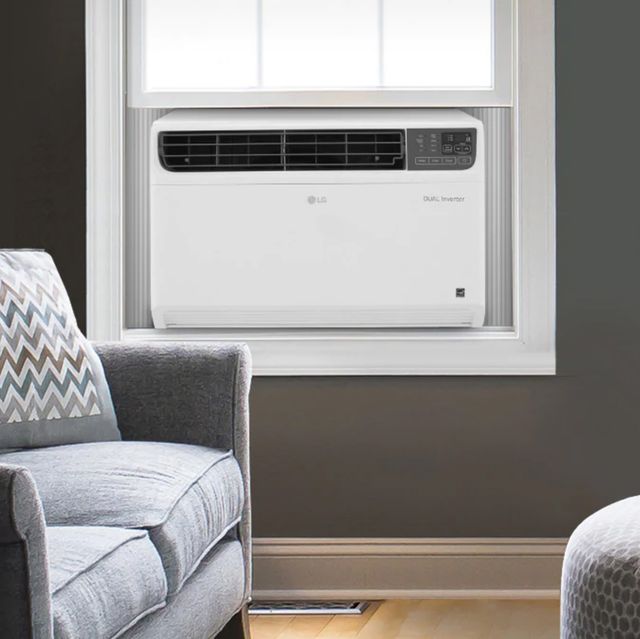
Source: Best Products
Smart air conditioners are more or less similar to regular air conditioners, except they can be operated using a tablet or a smartphone. Via a mobile app, you can switch your AC on and off at a particular time of the day, even when you’re away from home. You can also adjust the room temperature or create a cooling schedule at the click of a button or with voice commands.
To adjust the settings to your preference, the only thing needed is a stable internet connection (Wi-Fi) on your smart device.
Today, smart features are added to the majority of air conditioners, from portable air conditioners to window units. Typically, smart air conditioners range between $200 and $8,000, depending on the model and brand you opt for.
Advantages Of A Smart Air Conditioner
- Reduces energy consumption and cost
- Compatible with a wide variety of smart systems
- Allows you to operate your unit remotely
- Reduces carbon footprint
Disadvantages Of A Smart Air Conditioner
- Requires Wi-Fi to function
3. Evaporative Air Conditioner

Source: Pinterest
Often referred to as a swamp air conditioner, an evaporative air conditioner is yet another option that homeowners must consider for cooling their space. Evaporative air conditioners are one of the oldest units, relying on ice and water instead of refrigerant to supply cool air within a space, which separates them from regular ACs.
Pads soaked in cold water or tubs of ice are placed in front of these ACs, which convert warm air into cool air before blowing it across the room.
Yes, a whole-home evaporative air conditioner system is expensive, but finding one for your small space wouldn’t be a problem. That’s because they are available at prices as low as $100 to as high as $7,000 or above.
One major drawback of such AC units is they function only when filled with ice or cold water. So, if you’re planning to go for this system, keep in mind that you have to keep tabs on the unit and refill it every now and then.
Also, evaporative AC units are known to increase the humidity levels of a space. Keeping that in mind, I suggest you refrain from going for it if high humidity is a persistent issue.
Advantages Of An Evaporative Air Conditioner
- Doesn’t rely on ozone-depleting substances like Freon for cooling
- Available as both whole-home and portable units
- Sold for as low as $100
Disadvantages Of An Evaporative Air Conditioner
- Increases humidity levels of a space
4. Dual Fuel Or Hybrid Air Conditioner
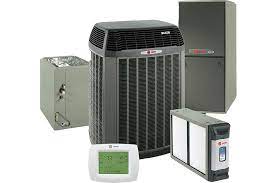
Source: ByrumHVAC
A dual-fuel air conditioner, also known as hybrid AC, integrates an electric-source heat pump with a gas furnace for efficient yet cost-effective performance.
Interestingly, such systems switch between electricity and fossil fuels automatically depending on the weather outside. All you have to do is program the range at which the unit switches from the furnace to the heat pump and vice versa. You can even change over from gas to pump manually, which I like about this unit.
In summer, the unit works as it is supposed to– pulls hot air and expels it outdoors. And when winter arrives, the process is reversed, as warm air is dispersed indoors.
Advantages Of A Dual Fuel Air Conditioner
- Low carbon footprint
- Makes space cozy and comfortable in all seasons
- Helps you save on utility bills
Disadvantages Of A Dual Fuel Air Conditioner
- Initial setup cost is high
Tip
When using an AC, consider two things: budget and energy efficiency rating (EER). Portable ACs and window ACs are the cheapest ones you will come across Mini-split systems or ductless ACs are dependable, cost-effective options for cooling more than one room at a time. Meanwhile, central air conditioning units are quite expensive; however, they are covered with a generous warranty and last long.

Final Thoughts
As you can see, there are multiple air conditioners, each suitable for use in different scenarios. However, before you get one for your home, there are a few important factors you need to consider, like the energy efficiency rating, cooling capacity, maintenance, and, budget.
While a central air conditioner would be a worthy option for cooling the entire home simultaneously, keep in mind it isn’t easy on the pockets. If you’re looking for an AC unit that doesn’t cost a bomb and is cost-effective, you can go for air-source heat pumps or window air conditioners.
An AC isn’t a home appliance that you upgrade every year, so opt for premium brands, even if that means overspending a tad bit because they don’t compromise on quality. Also, be sure to check SEER (seasonal energy efficiency ratio) ratings and customer reviews to ensure you spend money on the right appliance.
